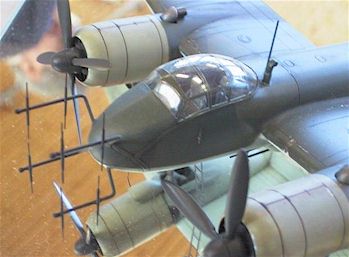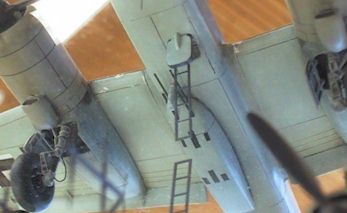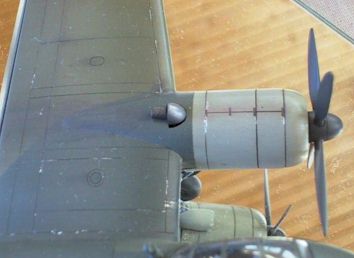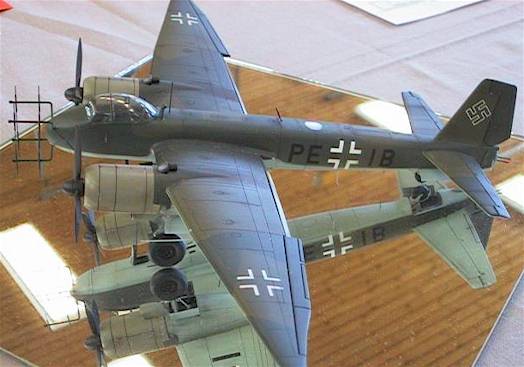Building the Junkers Ju 388
by Jan Forsgren
English translation by Martin Waligorski
Junkers Ju 388 V-2
The Junkers Ju 388 had been developed from Ju 188 as an advanced night fighter intended to replace the Ju 88G in service with the Luftwaffe. It differed from the Ju 188 in several aspects, two most prominent being a remotely controlled gun turret in the tail and a completely new front fuselage with pressurised crew compartment. The engines were intended to be either BMW 801G or Jumo 222, but late-delivery problems lead to twin BMW 801TJ powerplants being mounted on the prototypes.
V-2 depicted in my model was built as a prototype of the intended Ju 388 J-2 series. It carried SN-2 radar with those characteristic Hirschgeweih antennae. Offensive armament consisted of two Mg 151 and two MK108 cannon in gondola arrangement under the aircraft’s belly plus two more Mg 151s mounted in Shräge Musik configuration. The V-2 was test-flown in the end of 1944, and it has been fairly well documented on the preserved photographs.
It is believed that at least one of the Ju 388 prototypes was tested operationally by Kommando 388 early in 1945, but naturally it was too late for it to reach series production. The only Ju 388s to achieve that status where the ”K” (bomber) and ”L” (reconnaissance) models.
The Conversion
Originally I intended to use Toad Resin Ju 388 multimedia kit (mostly resin and white metal) as a base for this project, but it was not to be. After many considerations I chose to borrow the major parts from the Italeri Ju 188.
This left me with a pleasure of a considerable  scratch-building effort. I started my work with forming a new forward fuselage shell from sheet styrene, and furnishing interior detail. Seats were taken from AMT Ju 88G kit, but everything else was either scratchbuilt or recycled form the spares box.
scratch-building effort. I started my work with forming a new forward fuselage shell from sheet styrene, and furnishing interior detail. Seats were taken from AMT Ju 88G kit, but everything else was either scratchbuilt or recycled form the spares box.
Rear fuselage also required extensive reworking with enlarged cross-section and place for the tail turret.
The Toad kit served with the cockpit canopy, fin and rudder and the periscope arrangement. Adding the cannon gondola completed the fuselage work.
I machined the propeller spinners. As I couldn’t find the eight blades of the appropriate shape, I scratch-built a master and cast the blades in resin.
The Italeri wing was improved by dropping the flaps.  All panel lines (of the fine rised variety in the Italeri kit) were sanded off and then carefully rescribed. The cowlings were lengthened and new exhaust pipes added. Undercarriage legs and actuators came fom AMT Ju 88G.
All panel lines (of the fine rised variety in the Italeri kit) were sanded off and then carefully rescribed. The cowlings were lengthened and new exhaust pipes added. Undercarriage legs and actuators came fom AMT Ju 88G.
Scratch-built radar antennae dominated the final detailing part. I also added the crew ladder leading to the open entry hatch. The construction was finished by adding more antennae under the wings and along the fuselage.
Paint scheme
The camouflage of V-2 was not appropriate for the night fighter of the period and rather conformed to bomber variants of Ju 188, which at the Junkers factory were painted RLM 70/71/65 until the very end of the war. A confusing fact is that other variant of the Ju 388 had completely different paint schemes. Well, anyway… I used Xtracolor for the camouflage. A selection of Superscale decals were applied for the markings. After some restrained weathering the entire aircraft was sprayed with Tamiya matt clear varnish.
night fighter of the period and rather conformed to bomber variants of Ju 188, which at the Junkers factory were painted RLM 70/71/65 until the very end of the war. A confusing fact is that other variant of the Ju 388 had completely different paint schemes. Well, anyway… I used Xtracolor for the camouflage. A selection of Superscale decals were applied for the markings. After some restrained weathering the entire aircraft was sprayed with Tamiya matt clear varnish.
Conclusion
Well, what can I say? I enjoyed the project, I’m pleased with the result – does model building get much better than this? Maybe it does! My model took the 1st place among converted & scratchbuilt aircraft models at IPMS Open 2000 in Stockholm. Go figure…
This article was originally published in IPMS Stockholm Magazine in August 2000.
